Addressing Obesity in Australia: An Applied System Thinking Report
VerifiedAdded on 2023/06/04
|7
|1639
|201
Report
AI Summary
This report provides a comprehensive analysis of the obesity epidemic in Australia, employing an applied system thinking framework. It begins by defining obesity, outlining its prevalence, and identifying contributing factors such as poor diet and lack of physical exercise. The report then examines the roles of various stakeholders within the healthcare system, including parents, healthcare professionals, and the government, in addressing and preventing obesity. Furthermore, it delves into the obstacles hindering the application of a system thinking approach, such as the global scope of the problem and the complex, multifaceted nature of obesity with its biological, psychological, and social implications. Finally, the report proposes new governance methods for applying a system thinking approach, emphasizing a holistic approach, cooperation among stakeholders, and the importance of breaking down complexities into manageable components to effectively address the obesity epidemic in Australia. The report concludes with a list of cited references.
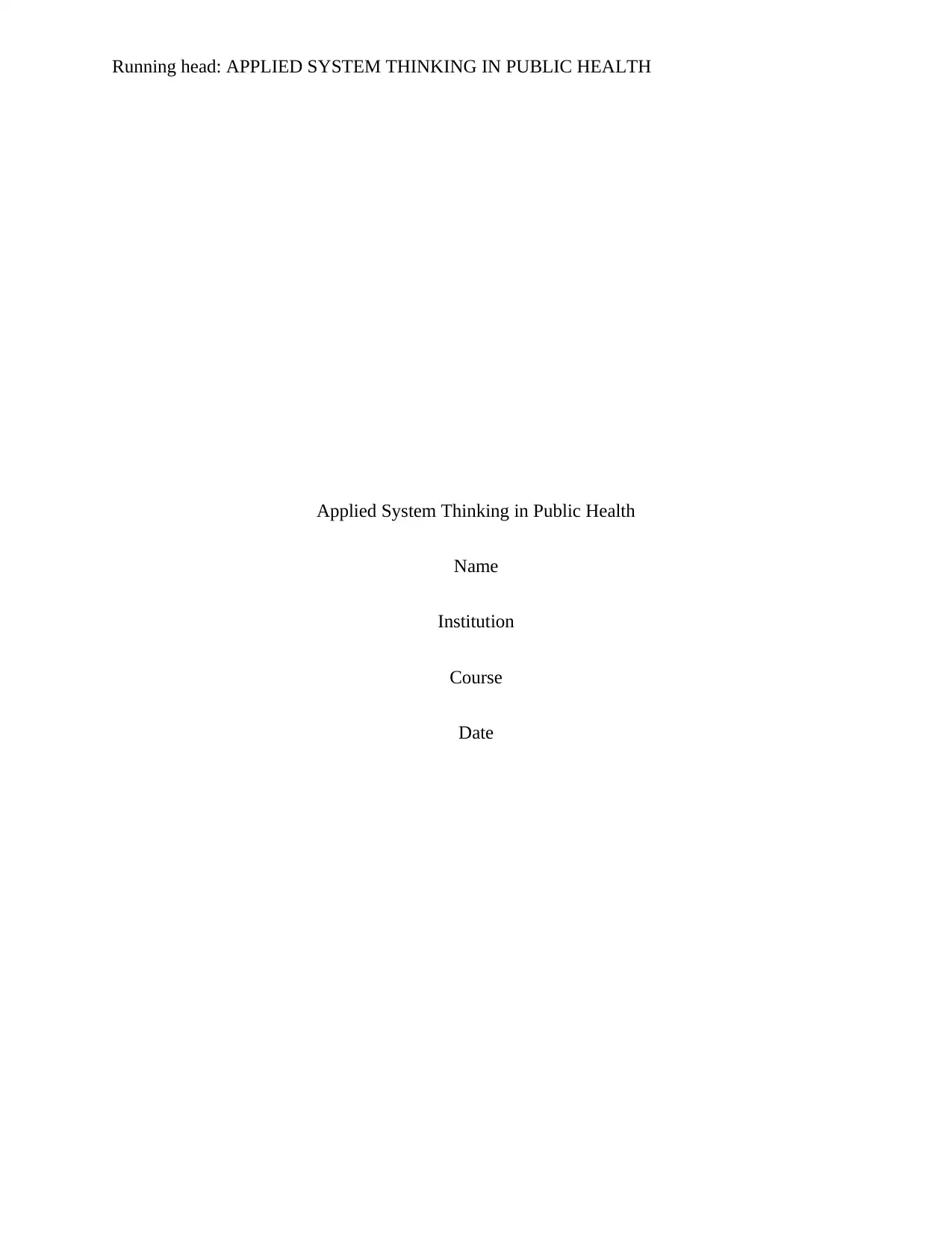
Running head: APPLIED SYSTEM THINKING IN PUBLIC HEALTH
Applied System Thinking in Public Health
Name
Institution
Course
Date
Applied System Thinking in Public Health
Name
Institution
Course
Date
Paraphrase This Document
Need a fresh take? Get an instant paraphrase of this document with our AI Paraphraser
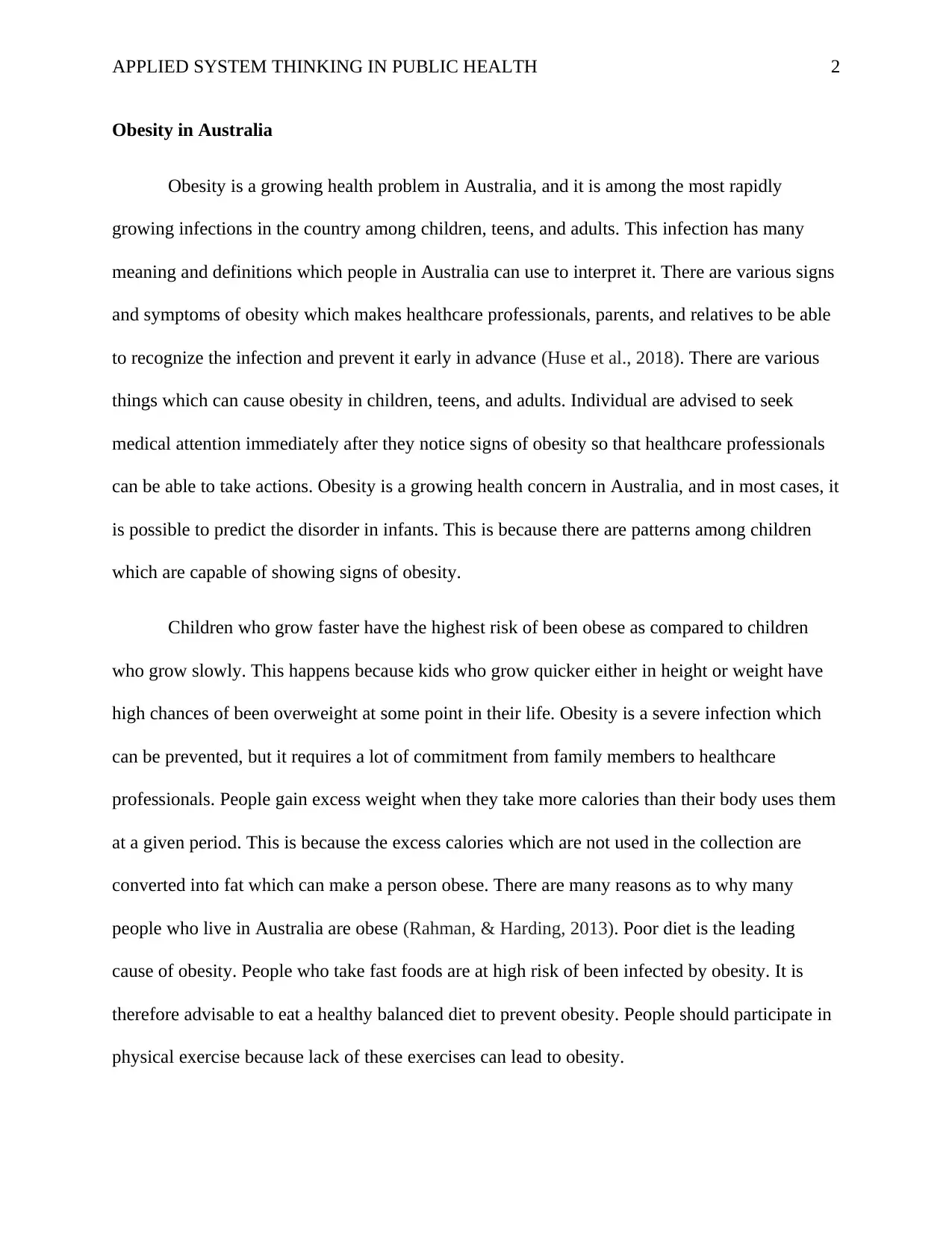
APPLIED SYSTEM THINKING IN PUBLIC HEALTH 2
Obesity in Australia
Obesity is a growing health problem in Australia, and it is among the most rapidly
growing infections in the country among children, teens, and adults. This infection has many
meaning and definitions which people in Australia can use to interpret it. There are various signs
and symptoms of obesity which makes healthcare professionals, parents, and relatives to be able
to recognize the infection and prevent it early in advance (Huse et al., 2018). There are various
things which can cause obesity in children, teens, and adults. Individual are advised to seek
medical attention immediately after they notice signs of obesity so that healthcare professionals
can be able to take actions. Obesity is a growing health concern in Australia, and in most cases, it
is possible to predict the disorder in infants. This is because there are patterns among children
which are capable of showing signs of obesity.
Children who grow faster have the highest risk of been obese as compared to children
who grow slowly. This happens because kids who grow quicker either in height or weight have
high chances of been overweight at some point in their life. Obesity is a severe infection which
can be prevented, but it requires a lot of commitment from family members to healthcare
professionals. People gain excess weight when they take more calories than their body uses them
at a given period. This is because the excess calories which are not used in the collection are
converted into fat which can make a person obese. There are many reasons as to why many
people who live in Australia are obese (Rahman, & Harding, 2013). Poor diet is the leading
cause of obesity. People who take fast foods are at high risk of been infected by obesity. It is
therefore advisable to eat a healthy balanced diet to prevent obesity. People should participate in
physical exercise because lack of these exercises can lead to obesity.
Obesity in Australia
Obesity is a growing health problem in Australia, and it is among the most rapidly
growing infections in the country among children, teens, and adults. This infection has many
meaning and definitions which people in Australia can use to interpret it. There are various signs
and symptoms of obesity which makes healthcare professionals, parents, and relatives to be able
to recognize the infection and prevent it early in advance (Huse et al., 2018). There are various
things which can cause obesity in children, teens, and adults. Individual are advised to seek
medical attention immediately after they notice signs of obesity so that healthcare professionals
can be able to take actions. Obesity is a growing health concern in Australia, and in most cases, it
is possible to predict the disorder in infants. This is because there are patterns among children
which are capable of showing signs of obesity.
Children who grow faster have the highest risk of been obese as compared to children
who grow slowly. This happens because kids who grow quicker either in height or weight have
high chances of been overweight at some point in their life. Obesity is a severe infection which
can be prevented, but it requires a lot of commitment from family members to healthcare
professionals. People gain excess weight when they take more calories than their body uses them
at a given period. This is because the excess calories which are not used in the collection are
converted into fat which can make a person obese. There are many reasons as to why many
people who live in Australia are obese (Rahman, & Harding, 2013). Poor diet is the leading
cause of obesity. People who take fast foods are at high risk of been infected by obesity. It is
therefore advisable to eat a healthy balanced diet to prevent obesity. People should participate in
physical exercise because lack of these exercises can lead to obesity.
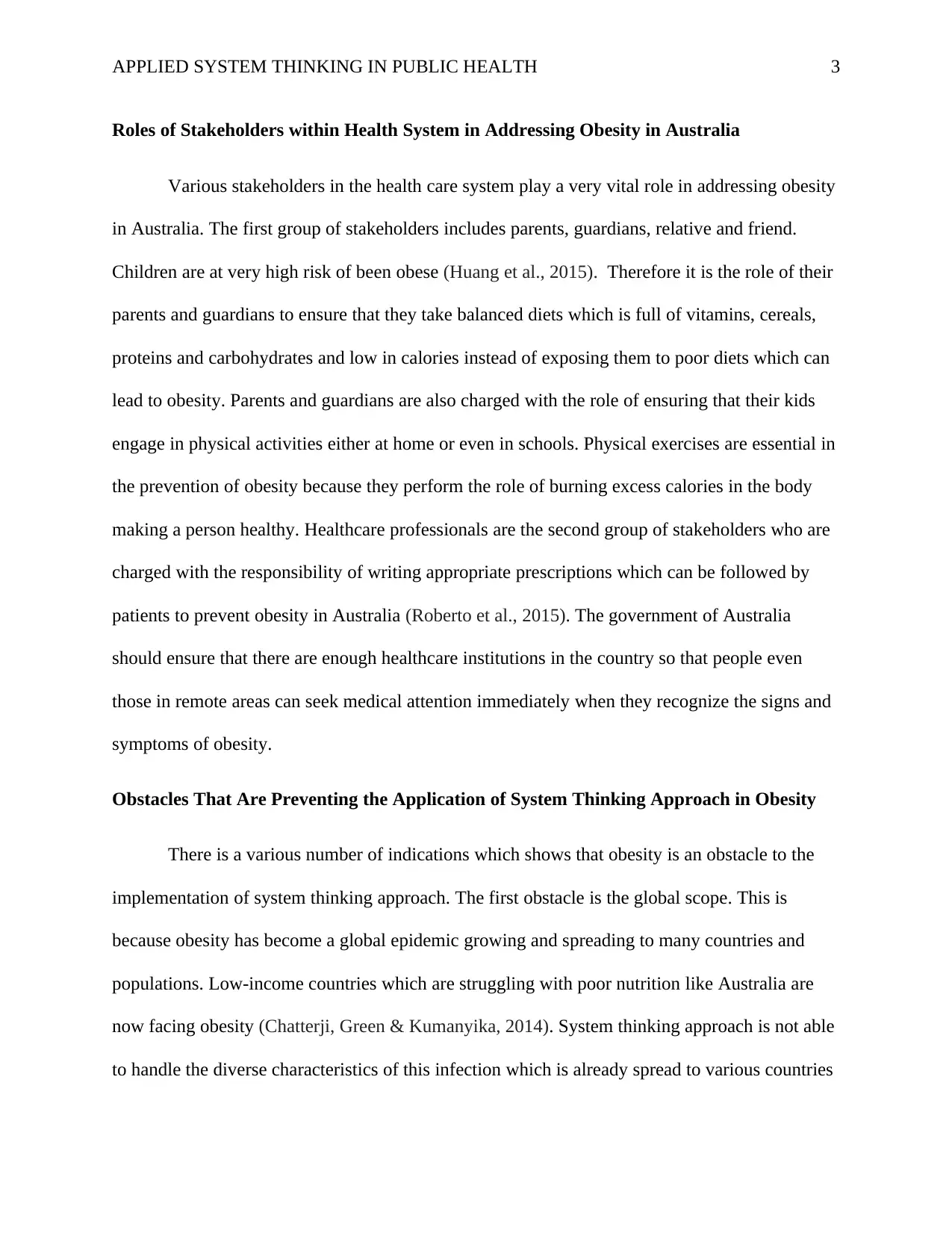
APPLIED SYSTEM THINKING IN PUBLIC HEALTH 3
Roles of Stakeholders within Health System in Addressing Obesity in Australia
Various stakeholders in the health care system play a very vital role in addressing obesity
in Australia. The first group of stakeholders includes parents, guardians, relative and friend.
Children are at very high risk of been obese (Huang et al., 2015). Therefore it is the role of their
parents and guardians to ensure that they take balanced diets which is full of vitamins, cereals,
proteins and carbohydrates and low in calories instead of exposing them to poor diets which can
lead to obesity. Parents and guardians are also charged with the role of ensuring that their kids
engage in physical activities either at home or even in schools. Physical exercises are essential in
the prevention of obesity because they perform the role of burning excess calories in the body
making a person healthy. Healthcare professionals are the second group of stakeholders who are
charged with the responsibility of writing appropriate prescriptions which can be followed by
patients to prevent obesity in Australia (Roberto et al., 2015). The government of Australia
should ensure that there are enough healthcare institutions in the country so that people even
those in remote areas can seek medical attention immediately when they recognize the signs and
symptoms of obesity.
Obstacles That Are Preventing the Application of System Thinking Approach in Obesity
There is a various number of indications which shows that obesity is an obstacle to the
implementation of system thinking approach. The first obstacle is the global scope. This is
because obesity has become a global epidemic growing and spreading to many countries and
populations. Low-income countries which are struggling with poor nutrition like Australia are
now facing obesity (Chatterji, Green & Kumanyika, 2014). System thinking approach is not able
to handle the diverse characteristics of this infection which is already spread to various countries
Roles of Stakeholders within Health System in Addressing Obesity in Australia
Various stakeholders in the health care system play a very vital role in addressing obesity
in Australia. The first group of stakeholders includes parents, guardians, relative and friend.
Children are at very high risk of been obese (Huang et al., 2015). Therefore it is the role of their
parents and guardians to ensure that they take balanced diets which is full of vitamins, cereals,
proteins and carbohydrates and low in calories instead of exposing them to poor diets which can
lead to obesity. Parents and guardians are also charged with the role of ensuring that their kids
engage in physical activities either at home or even in schools. Physical exercises are essential in
the prevention of obesity because they perform the role of burning excess calories in the body
making a person healthy. Healthcare professionals are the second group of stakeholders who are
charged with the responsibility of writing appropriate prescriptions which can be followed by
patients to prevent obesity in Australia (Roberto et al., 2015). The government of Australia
should ensure that there are enough healthcare institutions in the country so that people even
those in remote areas can seek medical attention immediately when they recognize the signs and
symptoms of obesity.
Obstacles That Are Preventing the Application of System Thinking Approach in Obesity
There is a various number of indications which shows that obesity is an obstacle to the
implementation of system thinking approach. The first obstacle is the global scope. This is
because obesity has become a global epidemic growing and spreading to many countries and
populations. Low-income countries which are struggling with poor nutrition like Australia are
now facing obesity (Chatterji, Green & Kumanyika, 2014). System thinking approach is not able
to handle the diverse characteristics of this infection which is already spread to various countries
⊘ This is a preview!⊘
Do you want full access?
Subscribe today to unlock all pages.

Trusted by 1+ million students worldwide
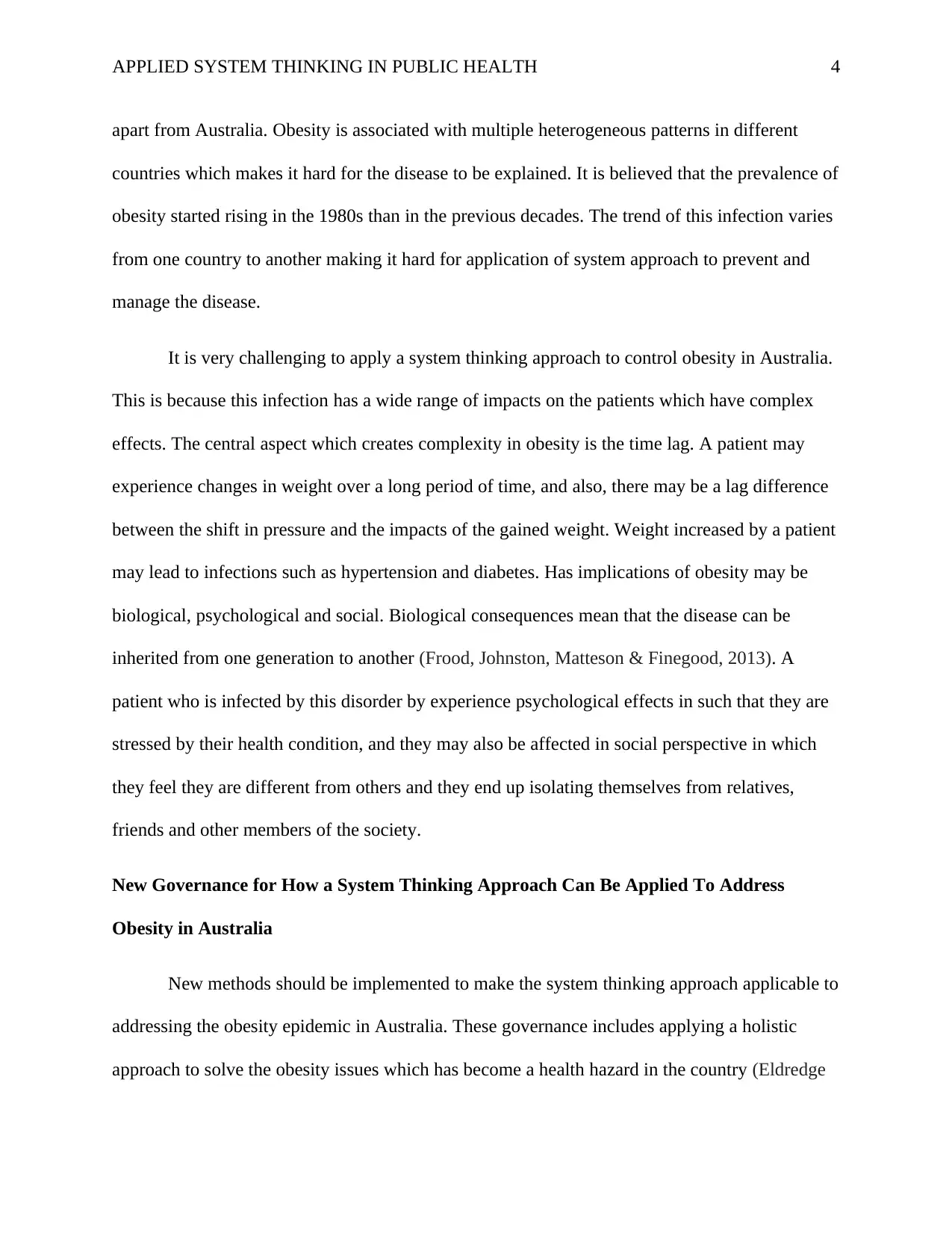
APPLIED SYSTEM THINKING IN PUBLIC HEALTH 4
apart from Australia. Obesity is associated with multiple heterogeneous patterns in different
countries which makes it hard for the disease to be explained. It is believed that the prevalence of
obesity started rising in the 1980s than in the previous decades. The trend of this infection varies
from one country to another making it hard for application of system approach to prevent and
manage the disease.
It is very challenging to apply a system thinking approach to control obesity in Australia.
This is because this infection has a wide range of impacts on the patients which have complex
effects. The central aspect which creates complexity in obesity is the time lag. A patient may
experience changes in weight over a long period of time, and also, there may be a lag difference
between the shift in pressure and the impacts of the gained weight. Weight increased by a patient
may lead to infections such as hypertension and diabetes. Has implications of obesity may be
biological, psychological and social. Biological consequences mean that the disease can be
inherited from one generation to another (Frood, Johnston, Matteson & Finegood, 2013). A
patient who is infected by this disorder by experience psychological effects in such that they are
stressed by their health condition, and they may also be affected in social perspective in which
they feel they are different from others and they end up isolating themselves from relatives,
friends and other members of the society.
New Governance for How a System Thinking Approach Can Be Applied To Address
Obesity in Australia
New methods should be implemented to make the system thinking approach applicable to
addressing the obesity epidemic in Australia. These governance includes applying a holistic
approach to solve the obesity issues which has become a health hazard in the country (Eldredge
apart from Australia. Obesity is associated with multiple heterogeneous patterns in different
countries which makes it hard for the disease to be explained. It is believed that the prevalence of
obesity started rising in the 1980s than in the previous decades. The trend of this infection varies
from one country to another making it hard for application of system approach to prevent and
manage the disease.
It is very challenging to apply a system thinking approach to control obesity in Australia.
This is because this infection has a wide range of impacts on the patients which have complex
effects. The central aspect which creates complexity in obesity is the time lag. A patient may
experience changes in weight over a long period of time, and also, there may be a lag difference
between the shift in pressure and the impacts of the gained weight. Weight increased by a patient
may lead to infections such as hypertension and diabetes. Has implications of obesity may be
biological, psychological and social. Biological consequences mean that the disease can be
inherited from one generation to another (Frood, Johnston, Matteson & Finegood, 2013). A
patient who is infected by this disorder by experience psychological effects in such that they are
stressed by their health condition, and they may also be affected in social perspective in which
they feel they are different from others and they end up isolating themselves from relatives,
friends and other members of the society.
New Governance for How a System Thinking Approach Can Be Applied To Address
Obesity in Australia
New methods should be implemented to make the system thinking approach applicable to
addressing the obesity epidemic in Australia. These governance includes applying a holistic
approach to solve the obesity issues which has become a health hazard in the country (Eldredge
Paraphrase This Document
Need a fresh take? Get an instant paraphrase of this document with our AI Paraphraser
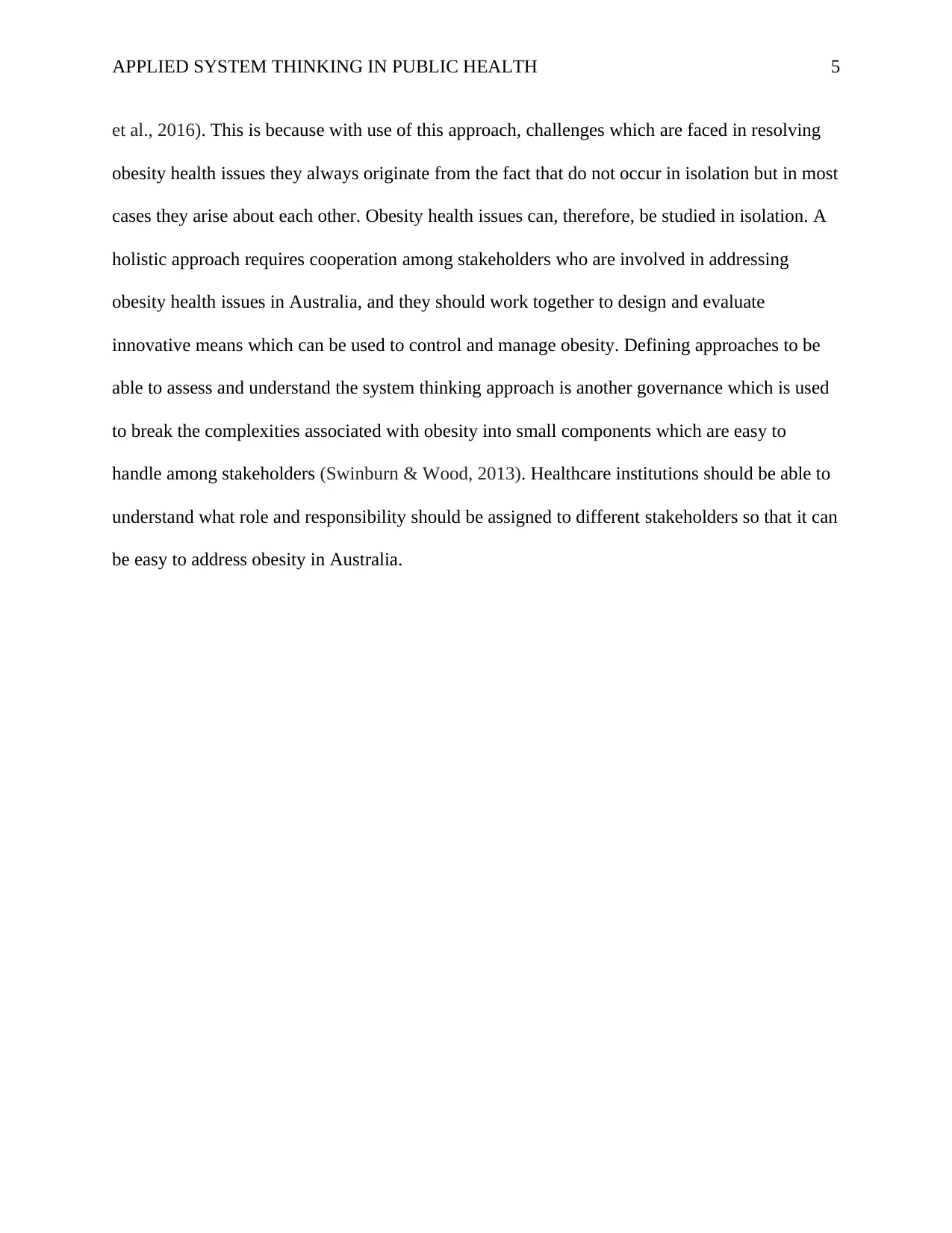
APPLIED SYSTEM THINKING IN PUBLIC HEALTH 5
et al., 2016). This is because with use of this approach, challenges which are faced in resolving
obesity health issues they always originate from the fact that do not occur in isolation but in most
cases they arise about each other. Obesity health issues can, therefore, be studied in isolation. A
holistic approach requires cooperation among stakeholders who are involved in addressing
obesity health issues in Australia, and they should work together to design and evaluate
innovative means which can be used to control and manage obesity. Defining approaches to be
able to assess and understand the system thinking approach is another governance which is used
to break the complexities associated with obesity into small components which are easy to
handle among stakeholders (Swinburn & Wood, 2013). Healthcare institutions should be able to
understand what role and responsibility should be assigned to different stakeholders so that it can
be easy to address obesity in Australia.
et al., 2016). This is because with use of this approach, challenges which are faced in resolving
obesity health issues they always originate from the fact that do not occur in isolation but in most
cases they arise about each other. Obesity health issues can, therefore, be studied in isolation. A
holistic approach requires cooperation among stakeholders who are involved in addressing
obesity health issues in Australia, and they should work together to design and evaluate
innovative means which can be used to control and manage obesity. Defining approaches to be
able to assess and understand the system thinking approach is another governance which is used
to break the complexities associated with obesity into small components which are easy to
handle among stakeholders (Swinburn & Wood, 2013). Healthcare institutions should be able to
understand what role and responsibility should be assigned to different stakeholders so that it can
be easy to address obesity in Australia.
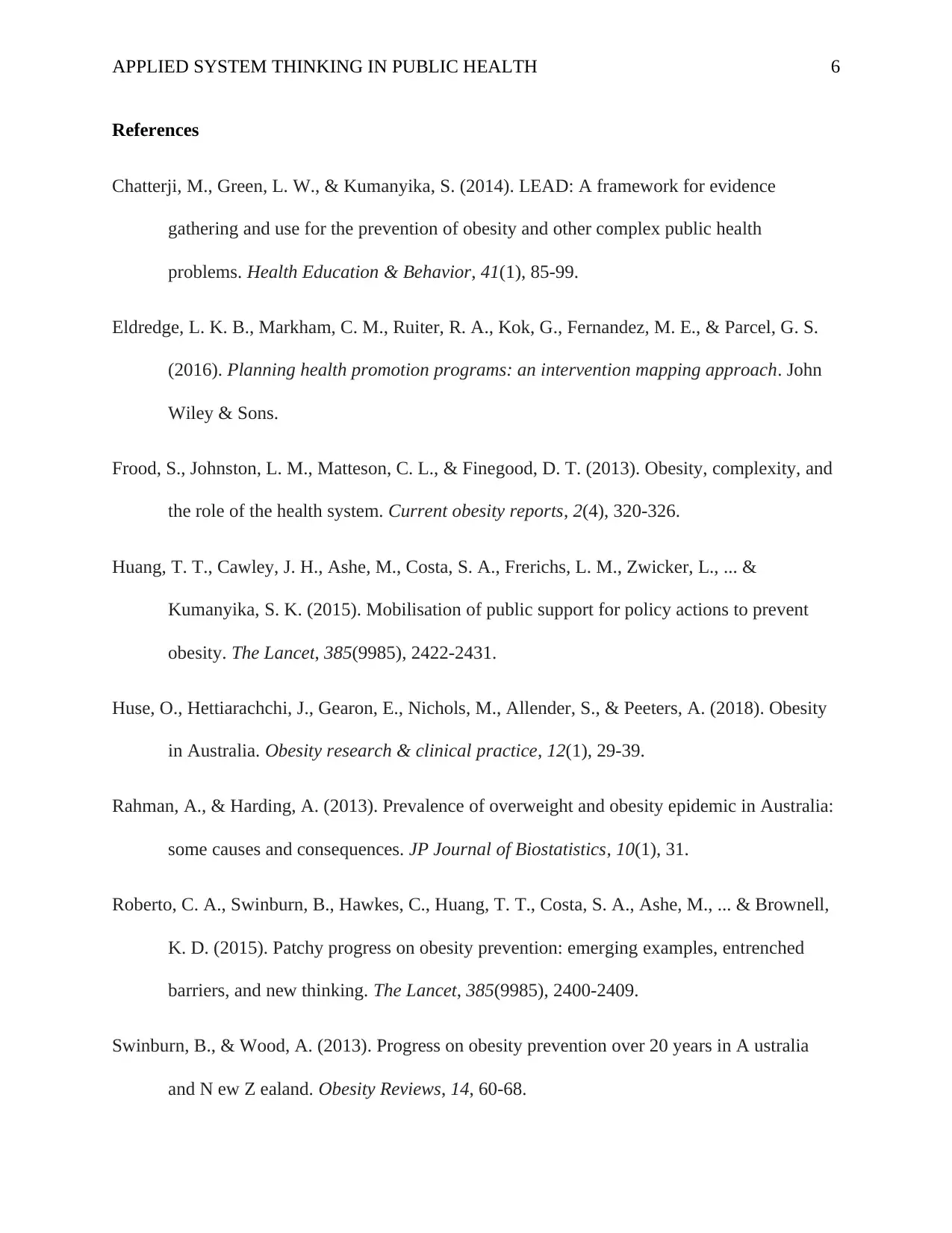
APPLIED SYSTEM THINKING IN PUBLIC HEALTH 6
References
Chatterji, M., Green, L. W., & Kumanyika, S. (2014). LEAD: A framework for evidence
gathering and use for the prevention of obesity and other complex public health
problems. Health Education & Behavior, 41(1), 85-99.
Eldredge, L. K. B., Markham, C. M., Ruiter, R. A., Kok, G., Fernandez, M. E., & Parcel, G. S.
(2016). Planning health promotion programs: an intervention mapping approach. John
Wiley & Sons.
Frood, S., Johnston, L. M., Matteson, C. L., & Finegood, D. T. (2013). Obesity, complexity, and
the role of the health system. Current obesity reports, 2(4), 320-326.
Huang, T. T., Cawley, J. H., Ashe, M., Costa, S. A., Frerichs, L. M., Zwicker, L., ... &
Kumanyika, S. K. (2015). Mobilisation of public support for policy actions to prevent
obesity. The Lancet, 385(9985), 2422-2431.
Huse, O., Hettiarachchi, J., Gearon, E., Nichols, M., Allender, S., & Peeters, A. (2018). Obesity
in Australia. Obesity research & clinical practice, 12(1), 29-39.
Rahman, A., & Harding, A. (2013). Prevalence of overweight and obesity epidemic in Australia:
some causes and consequences. JP Journal of Biostatistics, 10(1), 31.
Roberto, C. A., Swinburn, B., Hawkes, C., Huang, T. T., Costa, S. A., Ashe, M., ... & Brownell,
K. D. (2015). Patchy progress on obesity prevention: emerging examples, entrenched
barriers, and new thinking. The Lancet, 385(9985), 2400-2409.
Swinburn, B., & Wood, A. (2013). Progress on obesity prevention over 20 years in A ustralia
and N ew Z ealand. Obesity Reviews, 14, 60-68.
References
Chatterji, M., Green, L. W., & Kumanyika, S. (2014). LEAD: A framework for evidence
gathering and use for the prevention of obesity and other complex public health
problems. Health Education & Behavior, 41(1), 85-99.
Eldredge, L. K. B., Markham, C. M., Ruiter, R. A., Kok, G., Fernandez, M. E., & Parcel, G. S.
(2016). Planning health promotion programs: an intervention mapping approach. John
Wiley & Sons.
Frood, S., Johnston, L. M., Matteson, C. L., & Finegood, D. T. (2013). Obesity, complexity, and
the role of the health system. Current obesity reports, 2(4), 320-326.
Huang, T. T., Cawley, J. H., Ashe, M., Costa, S. A., Frerichs, L. M., Zwicker, L., ... &
Kumanyika, S. K. (2015). Mobilisation of public support for policy actions to prevent
obesity. The Lancet, 385(9985), 2422-2431.
Huse, O., Hettiarachchi, J., Gearon, E., Nichols, M., Allender, S., & Peeters, A. (2018). Obesity
in Australia. Obesity research & clinical practice, 12(1), 29-39.
Rahman, A., & Harding, A. (2013). Prevalence of overweight and obesity epidemic in Australia:
some causes and consequences. JP Journal of Biostatistics, 10(1), 31.
Roberto, C. A., Swinburn, B., Hawkes, C., Huang, T. T., Costa, S. A., Ashe, M., ... & Brownell,
K. D. (2015). Patchy progress on obesity prevention: emerging examples, entrenched
barriers, and new thinking. The Lancet, 385(9985), 2400-2409.
Swinburn, B., & Wood, A. (2013). Progress on obesity prevention over 20 years in A ustralia
and N ew Z ealand. Obesity Reviews, 14, 60-68.
⊘ This is a preview!⊘
Do you want full access?
Subscribe today to unlock all pages.

Trusted by 1+ million students worldwide

APPLIED SYSTEM THINKING IN PUBLIC HEALTH 7
1 out of 7
Related Documents
Your All-in-One AI-Powered Toolkit for Academic Success.
+13062052269
info@desklib.com
Available 24*7 on WhatsApp / Email
![[object Object]](/_next/static/media/star-bottom.7253800d.svg)
Unlock your academic potential
Copyright © 2020–2025 A2Z Services. All Rights Reserved. Developed and managed by ZUCOL.




